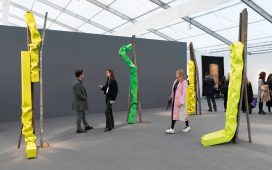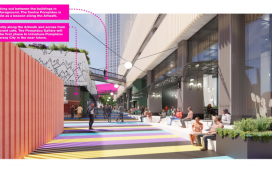‘Hospitals are the ugliest places in the world,” says Jacques Herzog. “They are a product of blind functionalist thinking, while neglecting basic human needs.” The Swiss architect has a point. With their low ceilings, windowless corridors and harsh fluorescent lighting, hospitals can sometimes seem consciously calibrated to make you feel ill, if you didn’t already. Attempts to jolly them up with coloured cladding panels and art commissions do little to distract from the bleak reality of buildings where the human experience – for patients, doctors and visitors alike – is often an afterthought.
Herzog insists it doesn’t have to be like this. And he has proof. He is standing in the circular entrance courtyard of his practice’s stunning riposte to the last century of grim healthcare buildings. It is a tranquil space reminiscent of a sylvan spa complex, ringed with sculpted wooden slats and planted with tall trees and ferns, where light bounces off marble sculptures that glisten in the drizzle. A broad gallery deck encircles the floor above, with a touch of Shakespeare’s Globe theatre, where bedrooms spill out on to wide, daylit corridors. Entering through revolving pink glass doors, you find a concrete staircase spiralling down into the foyer, curling around a core of colourful neon tubes that look ready to beam you upstairs.
Welcome to Zurich’s remarkable new children’s hospital, the Kinderspital – or “Kispi” for short – a 14-year endeavour to revolutionise how we think about the architecture of healing. It is not trying to be a fancy hotel, like some private hospitals with their plush carpets and room service. It is just a place where simple things like the quality of light and views, the scale and proportion of spaces and the texture of materials have been thought about with immense care, and honed to make the experience as pleasant as possible for everyone. Why should this be so unusual?
Herzog & de Meuron may not sound like an obvious choice to design a hospital. Over the years, its architects have built a reputation as consummate creators of cultural beacons, crafting mesmerising museums, concert halls and stadiums around the world, which revel in their structural and material alchemy. But alongside these glitzy commissions, the 600-strong practice has been quietly tackling the topic of healthcare for the last two decades. The firm completed an impressive, yet oddly undersung, rehabilitation clinic in Basel in 2002, and is now building a huge amoeba-shaped hospital in Denmark as well as a terracotta-clad ziggurat teaching hospital in San Fransisco. “It is an unbelievably neglected area,” says Herzog. “But I am totally convinced that architecture can contribute to the healing process.”
A wander around Kispi suggests he might be right. From the moment you encounter the cartoonishly oversized gates, splayed open like the entrance to a giant saloon, leading to the 16 planted courtyards that dot the building, it is unlike any other hospital. Spread across three 200-metre-long, 60-metre-wide floors, the vast building has been conceived as a town, with different departmental neighbourhoods either side of a meandering main street which widens and narrows, spilling on to side streets and squares. Rather than the usual identikit wards, the 200 patient rooms have been imagined as individual “cottages”, arranged as little wooden cabins around the perimeter of the top floor, with pitched roofs that tilt in different directions.
“We wanted to avoid that sense of being just another unit in a row of stacked boxes,” says project leader Mark Bähr. “Having a sloped wooden roof and natural light makes a huge psychological difference when you’re lying in bed staring at the ceiling all day.” The rooms have a more domestic feel than typical hospital rooms, like being in the attic of an alpine chalet. They have big picture windows and clever window seats that can be pulled out to become beds, giving weary parents a place to sleep. Fun porthole windows at child height can be opened for natural ventilation, while every room has an en suite bathroom – a welcome change from the previous hospital’s facilities, where 17 parents shared a shower. Wooden floors add a sense of warmth in contrast to the usual stark vinyl – and they’re just as hygienic, coated with ultra-hardwearing polyurethane.
From the outside, the low-lying complex is designed to look approachable and un-institutional, its long facade curving gently inwards to embrace the street. The friendly feeling is emphasised by the bedroom rooflines, tilting this way and that like a jaunty row of treehouses, perched on top of the concrete frame. The architects had originally proposed an entirely timber building but the client wanted something that felt more substantial, and they’ve made the most of the compromise. The frame is treated as a big armature, within which the lighter-weight partitions can be moved, should the hospital need to reconfigure. “We’ve already designed options for future expansion,” says Bähr, including the possibility of an extra storey on the roof, while the offices are future-proofed with services to become medical spaces if needed.
There are child-friendly touches throughout, from a low-level reception desk, so kids can see over it when they arrive, to cushion-filled cubbyholes and corridors wide enough for ping pong and football to take over. In very un-Swiss-minimalist fashion, the walls are even coated to encourage scribbling. “We’ve tried to make the architecture address the curiosity of children,” says Christine Binswanger, partner in charge of the project, who also led the design of Basel’s rehab clinic – a timber-framed, courtyard-studded facility which set the template for Kispi. “Normally they would expect you to paint animals on the walls, but we’ve done things like putting the timber columns on little round pieces of stone, or making a hole in the elevator so you can see into the shaft.” Forthcoming play areas will crank up the fun a few more notches.
after newsletter promotion
Navigating the previous hospital required being accompanied by a guide, but here the way-finding is eased with simple moves. Large amounts of glazing make it simple to spot staff, while the corridors end in big windows, framing views out to trees, rather than terminating in blank dead-ends. The bedrooms are staggered in a gentle sweep, avoiding relentless hotel-like rows of anonymous doors, while the two characterful staircases help to find your way back to the entrance.
With more than 2,300 rooms, the attention to detail is staggering (a decade-long process that was brought to life in the firm’s recent Royal Academy exhibition). The architects designed 700 different pieces of built-in furniture, including fold-down tables in treatment rooms, so parents can sit and talk to the physicians, and little tables in waiting areas, strapped on to the pentagonal concrete columns – even the profile of the structural frame shaped to add interest. Just when you think you’ve seen it all, one glowing doorway leads into a James Turrell skyspace, an oval chapel-like room where patients can bathe beneath an ever-changing rainbow of therapeutic light.
Operated by the Eleonore Foundation, a charity founded in 1868, the Kinderspital is known for its specialisms in oncology, cardiology, neonatology and burns – fields whose boundaries are being pushed in a dedicated research tower across the street, also designed by Herzog & de Meuron. Standing as a foil to the low-lying carpet of the hospital, the research labs are housed in a bright white cylinder, like a stack of Polo mints, where workspaces open on to a bright atrium reminiscent of New York’s Guggenheim museum. Three ground floor lecture theatres have been intelligently designed with sliding timber walls, which can retract to allow the whole space to become a single, circular agora, while a pair of corkscrew staircases bring some of the architects’ trademark theatrics to proceedings.
It would be easy to assume that this dazzling medial utopia is the product of Swiss exceptionalism, only possible in such a small, rich, well-resourced country. But that’s not entirely true. The hospital alone cost £517m to build (or £6,500 per square metre), sourced from a combination of private donors and public funds. It’s tricky to make a direct comparison, but two recent British hospitals – the Royal Liverpool and the Midland Metropolitan in Smethwick – each cost at least £7,770 per square metre, although they do contain three times the number of beds. Both were years late and cost hundreds of millions more than planned, and both were the product of failed £1bn PFI (private finance initiative) contracts with doomed contractor Carillion. Both have suffered a litany of problems.
Thoughtful, humane design doesn’t have to cost more. From rigorous procurement, to a properly trained construction workforce, to understanding the benefits that architecture can bring, the story of Kispi provides powerful lessons that the UK’s ill-fated hospital building programme would do well to learn from. Wes Streeting should pay a visit.








